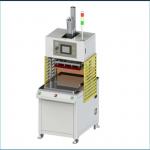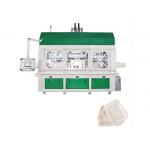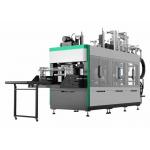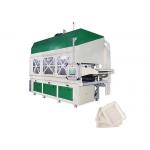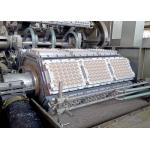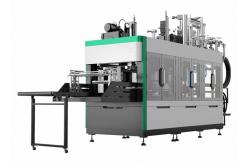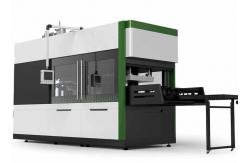Semi-Automatic Pulp Mold Tableware Machine
The Semi-Automatic Pulp Mold Tableware Machine offers several
notable features that contribute to its efficient and flexible
operation. Here are some key features commonly found in such
machines:
Manual Operation with Automated Processes: The machine combines
manual operation by an operator with automated processes, allowing
for more control and flexibility in the production process. The
operator performs tasks such as mold placement, pulp filling, and
de-molding, while the machine automates other processes like pulp
molding and drying.
- Versatile Molding Capabilities: The machine is designed to
accommodate various types of molds or dies, enabling the production
of a wide range of tableware products, including plates, bowls,
trays, and more. The molds can be easily changed or customized to
meet specific shape and size requirements.
- Efficient Pulping System: The machine features a pulping system
that efficiently breaks down waste paper or other fibrous materials
into pulp. It may incorporate mechanisms such as shredding,
soaking, and refining to achieve the desired pulp consistency.
- Hydraulic or Pneumatic Pressing System: To ensure uniformity and
proper compaction of the pulp, the machine is equipped with a
hydraulic or pneumatic pressing system. This system applies
pressure to the pulp-filled molds, resulting in well-formed and
sturdy tableware products.
- Drying System: The machine includes a drying section or compartment
where the molded products are subjected to heat or hot air. This
system effectively removes moisture from the products, allowing
them to solidify and become ready for de-molding.
- Control Panel and Parameters Adjustment: A control panel is
integrated into the machine, providing the operator with easy
access to control and monitor various parameters. These parameters
may include temperature, pressure, drying time, and production
speed. Adjusting these parameters ensures optimal performance and
product quality.
- Stacking and Packaging Assistance: Some semi-automatic machines may
offer stacking assistance, where the de-molded products are
automatically stacked in an organized manner for convenient
packaging and transportation. This feature streamlines the
post-production process and improves efficiency.
The Semi-Automatic Pulp Mold Tableware Machine combines the
advantages of manual operation and automated processes, making it
suitable for small to medium-scale production. Its versatility,
efficiency, and customizable features make it an ideal choice for
businesses looking to produce eco-friendly tableware with
flexibility and control.
Hot Pressing Shaping Machine Advantage
1,Mold Compatibility: The machine is designed to accommodate
different sizes and shapes of pulp molds. It should have the
flexibility to work with a variety of mold designs to produce
different types of molded products, such as egg trays, fruit trays,
or packaging inserts.
2,Temperature and Pressure Control: A pulp mold hot press machine
features precise temperature and pressure control mechanisms. These
controls ensure consistent and uniform heat distribution, as well
as accurate pressure application throughout the molding process.
The ability to regulate temperature and pressure enhances product
quality and reproducibility.
3,Automation and Efficiency: Advanced machines may incorporate
automation features to streamline the production process. This can
include automatic temperature and pressure adjustment, mold
changing mechanisms, and cycle timing controls. Automation helps
improve production efficiency, reduce human error, and increase
overall productivity.
4,Safety Features: Safety is an essential characteristic of any
machinery. A pulp mold hot press machine should have safety
features such as emergency stop buttons, protective covers, and
safety sensors to ensure the well-being of operators and prevent
accidents during operation.
5,Durability and Reliability: The machine should be constructed
from robust materials, ensuring durability and longevity.
High-quality components and a sturdy design contribute to the
reliability and consistent performance of the machine over an
extended period.
6,Energy Efficiency: Energy efficiency is a desirable
characteristic in a pulp mold hot press machine. Efficient heating
systems and insulation can help minimize energy consumption during
the molding process, resulting in cost savings and reduced
environmental impact.
7,Versatility and Adaptability: A versatile machine can adapt to
different pulp materials and production requirements. It should be
capable of handling various types of pulp, including recycled
paper, cardboard, or agricultural residues. Additionally, the
machine should offer flexibility in terms of producing different
product designs and sizes.
8,Maintenance and Serviceability: Ease of maintenance and
serviceability is important for minimizing downtime and optimizing
machine performance. A well-designed machine should provide
convenient access to components, easy cleaning, and straightforward
maintenance procedures.
9,Production Capacity: The production capacity of the machine,
expressed in terms of the number of molds or products it can
process per hour or per day, is an important characteristic. The
machine's capacity should align with the desired production volume
and meet the demands of the intended application.
These characteristics collectively define the capabilities and
functionality of a pulp mold hot press machine, enabling efficient
and reliable production of molded pulp products.
Paper Pulp Tableware Paremeters
| Machine Model | 15 Tons Hot Press |
| Dimensions | (15 Tons)980×660×1920(Mm) |
| Table size | (Single Cylinder)660x450 (Mm) |
| Workpiece Height That Can Be Produced | ≤150mm |
| Rated Voltage | Ac220V± 10% |
| Hot Pressing Time | 0~~6 Seconds Adjustable |
| Power | ≤7Kw |
Here are some key features and functions of a hot pressing shaping
machine:
Heating system: The machine is equipped with a heating system, such
as electric heaters or heating oil, to raise the temperature of the
material to the required level for shaping.
Pressure application: The machine applies pressure to the heated
material using hydraulic cylinders or mechanical mechanisms. The
pressure helps in compressing and forming the material into the
desired shape.
Temperature and pressure control: The machine allows for precise
control of temperature and pressure during the shaping process.
This control ensures consistent and accurate results.
Timer and cycle control: Hot press machines often have timers and
cycle control features, allowing operators to set the duration of
the heating and pressing cycles for optimal shaping results.
Safety features: To ensure operator safety, hot press machines may
have safety interlocks, emergency stop buttons, and
temperature/pressure monitoring systems.
Paper Pulp Tableware Display

